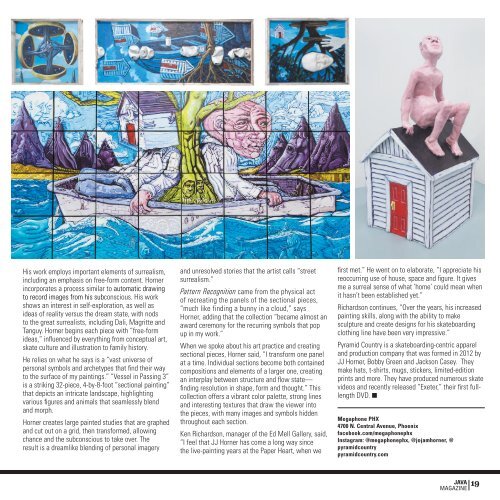You also want an ePaper? Increase the reach of your titles
YUMPU automatically turns print PDFs into web optimized ePapers that Google loves.
His work employs important elements of surrealism,<br />
including an emphasis on free-form content. Horner<br />
incorporates a process similar to automatic drawing<br />
to record images from his subconscious. His work<br />
shows an interest in self-exploration, as well as<br />
ideas of reality versus the dream state, with nods<br />
to the great surrealists, including Dali, Magritte and<br />
Tanguy. Horner begins each piece with “free-form<br />
ideas,” influenced by everything from conceptual art,<br />
skate culture and illustration to family history.<br />
He relies on what he says is a “vast universe of<br />
personal symbols and archetypes that find their way<br />
to the surface of my paintings.” “Vessel in Passing 3”<br />
is a striking 32-piece, 4-by-8-foot “sectional painting”<br />
that depicts an intricate landscape, highlighting<br />
various figures and animals that seamlessly blend<br />
and morph.<br />
Horner creates large painted studies that are graphed<br />
and cut out on a grid, then transformed, allowing<br />
chance and the subconscious to take over. The<br />
result is a dreamlike blending of personal imagery<br />
and unresolved stories that the artist calls “street<br />
surrealism.”<br />
Pattern Recognition came from the physical act<br />
of recreating the panels of the sectional pieces,<br />
“much like finding a bunny in a cloud,” says<br />
Horner, adding that the collection “became almost an<br />
award ceremony for the recurring symbols that pop<br />
up in my work.”<br />
When we spoke about his art practice and creating<br />
sectional pieces, Horner said, “I transform one panel<br />
at a time. Individual sections become both contained<br />
compositions and elements of a larger one, creating<br />
an interplay between structure and flow state—<br />
finding resolution in shape, form and thought.” This<br />
collection offers a vibrant color palette, strong lines<br />
and interesting textures that draw the viewer into<br />
the pieces, with many images and symbols hidden<br />
throughout each section.<br />
Ken Richardson, manager of the Ed Mell Gallery, said,<br />
“I feel that JJ Horner has come a long way since<br />
the live-painting years at the Paper Heart, when we<br />
first met.” He went on to elaborate, “I appreciate his<br />
reoccurring use of house, space and figure. It gives<br />
me a surreal sense of what ‘home’ could mean when<br />
it hasn’t been established yet.”<br />
Richardson continues, “Over the years, his increased<br />
painting skills, along with the ability to make<br />
sculpture and create designs for his skateboarding<br />
clothing line have been very impressive.”<br />
Pyramid Country is a skateboarding-centric apparel<br />
and production company that was formed in 2012 by<br />
JJ Horner, Bobby Green and Jackson Casey. They<br />
make hats, t-shirts, mugs, stickers, limited-edition<br />
prints and more. They have produced numerous skate<br />
videos and recently released “Exeter,” their first fulllength<br />
DVD.<br />
Megaphone PHX<br />
4700 N. Central Avenue, Phoenix<br />
facebook.com/megaphonephx<br />
Instagram: @megaphonephx, @jojamhorner, @<br />
pyramidcountry<br />
pyramidcountry.com<br />
JAVA 19<br />
MAGAZINE


















